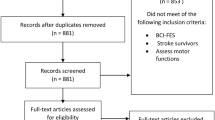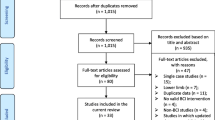Abstract
Purpose of Review
This systematic review of randomized controlled trials (RCTs) aimed to systematically evaluate the findings of the randomized controlled trials (RCTs) concerned with the use of CCFES on stroke survivors at acute, subacute, and chronic phases.
Recent Findings
This systematic review included seven RCTs, with mean PEDro score of 5.7 and total sample of 297 participants. Conflicting evidence was found about the effect of CCFES to improve gross manual dexterity assessed by BBT, and sensorimotor function of the upper limb evaluated by FMA-UE, in stroke patients, while no evidence was found on the effect of CCFES to improve activity limitation evaluated by AMAT, motor function of lower limb and gait, in stroke patients.
Summary
The current evidence could not affirm a definitive conclusion regarding the efficacy of CCFES in the stroke neurorehabilitation. High-quality RCTs with more specific assessment tools are required.

Similar content being viewed by others
References
Papers of particular interest, published recently, have been highlighted as: • Of importance
Feigin VL, et al. Global and regional burden of stroke during 1990–2010: findings from the Global Burden of Disease Study 2010. Lancet (London, England). 2014;383(9913):245–55. https://doi.org/10.1016/S0140-6736(13)61953-4.
Park SW, Son SM, Lee NK. Exercise-induced muscle fatigue in the unaffected knee joint and its influence on postural control and lower limb kinematics in stroke patients. Neural Regen Res. 2017;12(5):765. https://doi.org/10.4103/1673-5374.206647.
English C, et al. Additional weekend therapy may reduce length of rehabilitation stay after stroke: a meta-analysis of individual patient data. J Physiother. 2016;62(3):124–9. https://doi.org/10.1016/J.JPHYS.2016.05.015.
Knutson JS, Harley MY, Hisel TZ, Makowski NS, Chae J. Contralaterally controlled functional electrical stimulation for recovery of elbow extension and hand opening after stroke: a pilot case series study. Am J Phys Med Rehabil. 2014;93(6):528–39. https://doi.org/10.1097/PHM.0000000000000066.
Aqueveque P, Ortega P, Pino E, Saavedra F, Germany E, Gómez B. After stroke movement impairments: a review of current technologies for rehabilitation. Phys Disabil Ther Implic. 2017;14:95–116.
• Fu MJ, Curby A, Suder R, Katholi B, Knutson JS. Home-based functional electrical stimulation-assisted hand therapy video games for children with hemiplegia: development and proof-of-concept. IEEE Trans Neural Syst Rehabil Eng. 2020;28(6):1461–70. https://doi.org/10.1109/TNSRE.2020.2992036. The findings of this study suggested that CCFES-integrated video game therapy could improve the motor outcomes of hemiplegic children.
Cunningham DA, Knutson JS, Sankarasubramanian V, Potter-Baker KA, Machado AG, Plow EB. Bilateral contralaterally controlled functional electrical stimulation reveals new insights into the interhemispheric competition model in chronic stroke. Neurorehabil Neural Repair. 2019;33(9):707–17. https://doi.org/10.1177/1545968319863709.
•• Knutson JS, Harley MY, Hisel TZ, Makowski NS, Fu MJ, Chae J. Contralaterally Controlled Functional Electrical Stimulation for stroke rehabilitation. Conf Proc IEEE Eng Med Biol Soc. 2012;2012:314. https://doi.org/10.1109/EMBC.2012.6345932. This article discussed the rationale, uses, results, and future directions of CCFES.
Turolla A, Venneri A, Farina D, Cagnin A, Cheung VCK. Rehabilitation induced neural plasticity after acquired brain injury. Neural Plast. 2018;2018:6565418. https://doi.org/10.1155/2018/6565418.
Chan MKL, Tong RKY, Chung KYK. Bilateral upper limb training with functional electric stimulation in patients with chronic stroke. Neurorehabil Neural Repair. 2009;23(4):357–65. https://doi.org/10.1177/1545968308326428.
Eng K, et al. Interactive visuo-motor therapy system for stroke rehabilitation. Med Biol Eng Comput. 2007;45(9):901–7. https://doi.org/10.1007/S11517-007-0239-1.
Hara Y. Rehabilitation with functional electrical stimulation in stroke patients. Artic Int J Phys Med Rehabil. 2013;1(6):147. https://doi.org/10.4172/2329-9096.1000147.
Knutson JS, Chae J. A novel neuromuscular electrical stimulation treatment for recovery of ankle dorsiflexion in chronic hemiplegia: a case series pilot study. Am J Phys Med Rehabil. 2010;89(8):672–82. https://doi.org/10.1097/PHM.0B013E3181E29BD7.
Liberati A, Altman DG, Tetzlaff J, Mulrow C, Gøtzsche PC, Ioannidis JP, Clarke M, Devereaux PJ, Kleijnen J, Moher D. The PRISMA statement for reporting systematic reviews and meta-analyses of studies that evaluate health care interventions: explanation and elaboration. J Clin Epidemiol. 2009;62(10):e1–34.
Maher CG, Sherrington C, Herbert RD, Moseley AM, Elkins M. Reliability of the PEDro scale for rating quality of randomized controlled trials. Phys Ther. 2003;83(8):713–21. https://doi.org/10.1093/PTJ/83.8.713.
Burns PB, Rohrich RJ, Chung KC. The levels of evidence and their role in evidence-based medicine. Plast Reconstr Surg. 2011;128(1):305. https://doi.org/10.1097/PRS.0B013E318219C171.
de Morton NA. The PEDro scale is a valid measure of the methodological quality of clinical trials: a demographic study. Aust J Physiother. 2009;55(2):129–33. https://doi.org/10.1016/S0004-9514(09)70043-1.
Foley NC, Bhogal SK, Teasell RW, Bureau Y, Speechley MR. Estimates of quality and reliability with the physiotherapy evidence-based database scale to assess the methodology of randomized controlled trials of pharmacological and nonpharmacological interventions. Phys Ther. 2006;86(6):817–24. https://doi.org/10.1093/PTJ/86.6.817.
Zheng Y, Mao M, Cao Y, Lu X. Contralaterally controlled functional electrical stimulation improves wrist dorsiflexion and upper limb function in patients with early-phase stroke: a randomized controlled trial. J Rehabil Med. 2019;51(2):103–8. https://doi.org/10.2340/16501977-2510.
Knutson JS, Gunzler DD, Wilson RD, Chae J. Contralaterally Controlled Functional Electrical Stimulation improves hand dexterity in chronic hemiparesis: a randomized trial. Stroke. 2016;47(10):2596–602. https://doi.org/10.1161/STROKEAHA.116.013791.
Carda S, et al. Electrically assisted movement therapy in chronic stroke patients with severe upper limb paresis: a pilot, single-blind, randomized crossover study. Arch Phys Med Rehabil. 2017;98(8):1628-1635.e2. https://doi.org/10.1016/J.APMR.2017.02.020.
Knutson JS, et al. Adding Contralaterally Controlled Electrical Stimulation of the triceps to contralaterally controlled functional electrical stimulation of the finger extensors reduces upper limb impairment and improves reachable workspace but not dexterity: a randomized controlled trial. Am J Phys Med Rehabil. 2020;99(6):514–21. https://doi.org/10.1097/PHM.0000000000001363.
Knutson JS, Harley MY, Hisel TZ, Hogan SD, Maloney MM, Chae J. Contralaterally controlled functional electrical stimulation for upper extremity hemiplegia: an early-phase randomized clinical trial in subacute stroke patients. Neurorehabil Neural Repair. 2012;26(3):239–46. https://doi.org/10.1177/1545968311419301.
Knutson JS, et al. Contralaterally controlled neuromuscular electrical stimulation for recovery of ankle dorsiflexion: A pilot randomized controlled trial in patients with chronic post-stroke hemiplegia. Am J Phys Med Rehabil. 2013;92(8):656–65. https://doi.org/10.1097/PHM.0B013E31829B4C16.
Zhou YX, et al. Electromyographic bridge for promoting the recovery of hand movements in subacute stroke patients: a randomized controlled trial. J Rehabil Med. 2017;49(8):629–36. https://doi.org/10.2340/16501977-2256.
Gladstone DJ, Danells CJ, Black SE. The fugl-meyer assessment of motor recovery after stroke: a critical review of its measurement properties. Neurorehabil Neural Repair. 2002;16(3):232–40. https://doi.org/10.1177/154596802401105171.
Desrosiers J, Bravo G, Hébert R, Dutil É, Mercier L. Validation of the Box and Block Test as a measure of dexterity of elderly people: reliability, validity, and norms studies. Arch Phys Med Rehabil. 1994;75(7):751–5. https://doi.org/10.1016/0003-9993(94)90130-9.
Kopp B, et al. The Arm Motor Ability Test: reliability, validity, and sensitivity to change of an instrument for assessing disabilities in activities of daily living. Arch Phys Med Rehabil. 1997;78(6):615–20. https://doi.org/10.1016/S0003-9993(97)90427-5.
Jones TA. Motor compensation and its effects on neural reorganization after stroke. Nat Rev Neurosci. 2017;18(5):267–80. https://doi.org/10.1038/NRN.2017.26.
Qian Q, et al. Distal versus proximal - an investigation on different supportive strategies by robots for upper limb rehabilitation after stroke: a randomized controlled trial. J Neuroeng Rehabil. 2019;16(1):1–16. https://doi.org/10.1186/S12984-019-0537-5/FIGURES/4.
• Kwakkel G, et al. Standardized measurement of quality of upper limb movement after stroke: consensus-based core recommendations from the Second Stroke Recovery and Rehabilitation Roundtable. Int J Stroke. 2019;14(8):783–91. https://doi.org/10.1177/1747493019873519. This article described the criteria for upper extremity movement assessment after stroke.
O’Dell MW, Kim G, Finnen LR, Polistena C. Clinical implications of using the arm motor ability test in stroke rehabilitation. Arch Phys Med Rehabil. 2011;92(5):830–6. https://doi.org/10.1016/J.APMR.2010.09.020.
Author information
Authors and Affiliations
Corresponding author
Ethics declarations
Conflict of Interest
The authors declare no conflict of interest.
Human and Animal Rights and Informed Consent
This article does not contain any studies with human or animal subjects performed by any of the authors.
Additional information
Publisher's Note
Springer Nature remains neutral with regard to jurisdictional claims in published maps and institutional affiliations.
This article is part of the Topical Collection on Brain Injury Medicine and Rehabilitation
Rights and permissions
About this article
Cite this article
Hendawy, A., Ali, A.A.Z., Mahmoud, M. et al. The Effectiveness of the Contralaterally Controlled Functional Electrical Stimulation in Post-stroke Patients: a Systematic Review. Curr Phys Med Rehabil Rep 10, 52–60 (2022). https://doi.org/10.1007/s40141-022-00340-z
Accepted:
Published:
Issue Date:
DOI: https://doi.org/10.1007/s40141-022-00340-z




